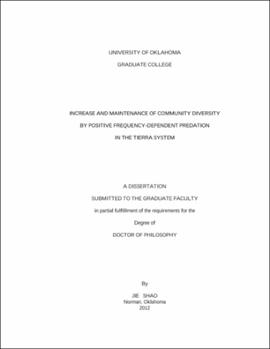| dc.contributor.advisor | Rsy, Thomas S | |
| dc.creator | Shao, Jie | |
| dc.date.accessioned | 2019-04-27T21:36:57Z | |
| dc.date.available | 2019-04-27T21:36:57Z | |
| dc.date.issued | 2012 | |
| dc.identifier | 99346041102042 | |
| dc.identifier.uri | https://hdl.handle.net/11244/319169 | |
| dc.description.abstract | Ecological communities often contain a wide diversity of species but how different species may arise and stably coexist, especially in homogenous spatial environments, is poorly understood. In this dissertation, I use the well-known digital life system, Tierra, to explore the influence of predation on community diversity in a homogenous environment. In order to introduce predation into the Tierra system, I design a digital predator whose survival and reproduction depend on the amount of CPU energy acquired through predation. This energy dependence of predators on their prey robustly generates a "Lotka-Volterra-like" cyclic oscillation in Tierra. This cyclic outcome suggests that the design of digital prey and predators may capture some essential properties of the predation relationship observed in nature. | |
| dc.description.abstract | After predation is built into the Tierra system, I study two predation strategies that predators may use when encountering two or more different types of prey, namely, proportional predation and positive frequency-dependent predation. I block all the mutations in Tierra so that predators and prey interact with each other in an ecological scenario. The simulation results show that a predator population with positive frequency-dependent behavior maintains a stable coexistence of multiple competing prey species, but a predator population with proportional predation behavior fails to do so. Further studies on the underlying mechanisms of the maintenance of prey diversity reveal that by consuming disproportionately more of the common prey type than of the rare one, positive frequency-dependent predation essentially provides a strong negative feedback regulation on prey populations, which tends to equalize the abundances of different prey species and thus results in a stable persistence of prey diversity. Therefore, in contrast to the previous studies which questioned whether the mechanism of positive frequency-dependent predation functioned at a population level, the simulation results here strongly support that a population of frequency-dependent predators has the potential to maintain the diversity of prey species in nature. | |
| dc.description.abstract | Besides their effects on maintaining prey diversity, the two predation strategies are further examined from the perspective of enhancing the fitness of predators when they feed on two different types of prey. The simulation results show that when the predators with one predation strategy become the dominant type, they change the relative abundance of two prey types in such a way that favors, rather than depresses, the predators with the other predation strategy. This mutual support, rather than exclusion, allows the two predation strategies to be comparably competitive and thus may coexist in the population or either one of them may go extinct. | |
| dc.description.abstract | With the understanding of prey diversity maintained by a population of predators with positive frequency-dependent behavior in the ecological scenarios, I proceed to explore the changes in community diversity influenced by predators during evolution when various types of mutations in Tierra are turned on to allow digital creatures to evolve. The simulation results show that the community with persistent intensive predation robustly exhibits significantly higher diversity than the community without predation. Therefore, positive frequency-dependent predation may also be able to promote and maintain a high level of diversity in an evolving ecological community. In addition, with the presence of predation in the community, the sizes of digital creatures remain relatively constant during evolution, which prevents the loss of complex structures in the genomes of creatures as well as promoting rich interactions among creatures. This suggests that the community of prey and predators may maintain interesting ecological dynamics through longer periods of evolution. Furthermore, as digital creatures constantly adapt to their ever-changing biotic environment, a coevolving pattern between prey and predator populations spontaneously emerges in Tierra: prey mutate their templates to avoid being found by predators and predators evolve their templates to circumvent the escape strategy developed in the newly evolved prey. These reciprocal adaptations may continuously create new niches and thus drive the evolution of prey and predators in the digital community. | |
| dc.format.extent | 180 pages | |
| dc.format.medium | application.pdf | |
| dc.language | en_US | |
| dc.relation.requires | Adobe Acrobat Reader | |
| dc.subject | Predation (Biology) | |
| dc.subject | Biological systems--Computer simulation | |
| dc.title | Increase and Maintenance of Community Diversity by Positive Frequency-dependent Predation in the Tierra System | |
| dc.type | text | |
| dc.type | document | |
| dc.thesis.degree | Ph.D. | |
| ou.group | College of Arts and Sciences::Department of Biology | |
